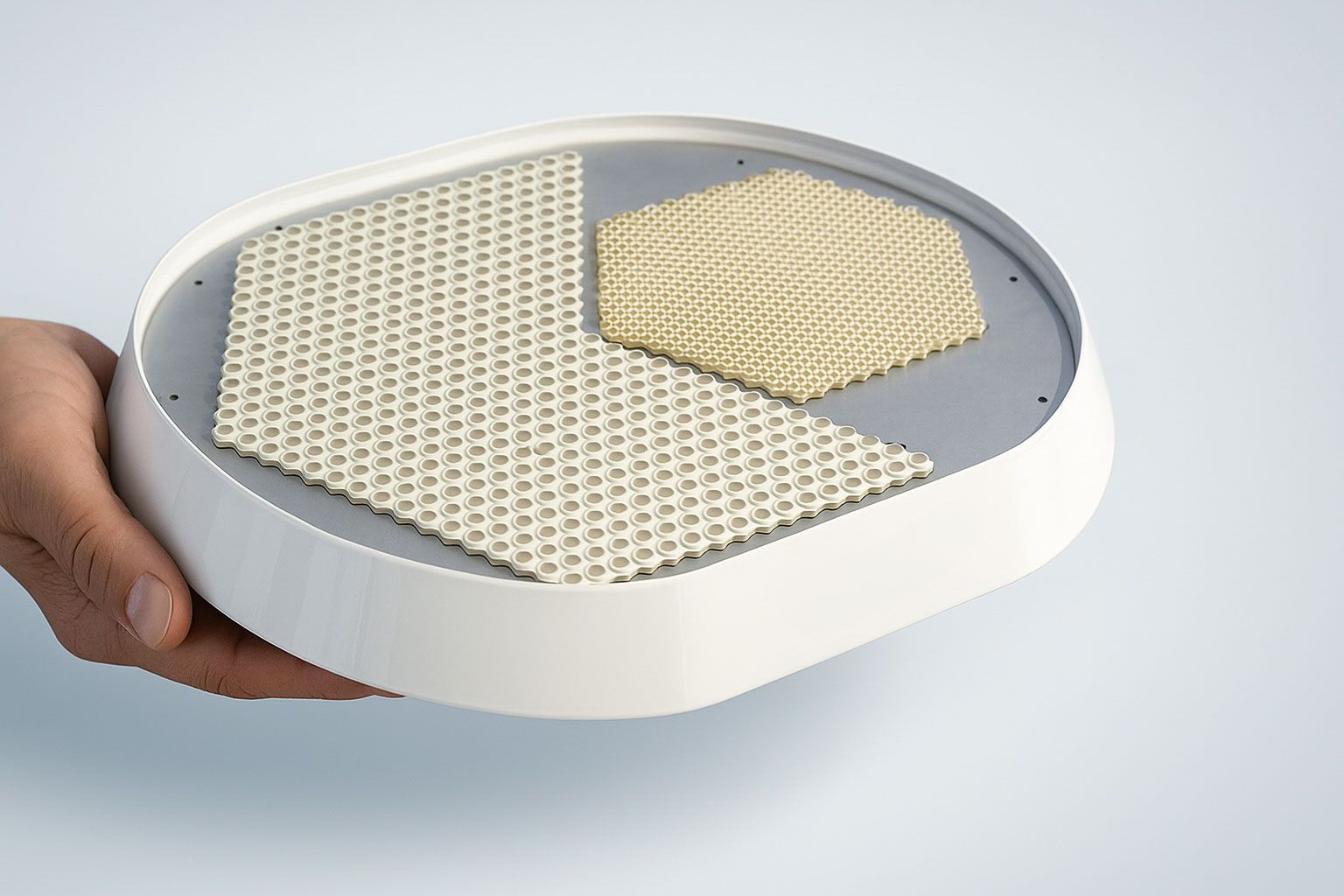- The global market for flat-panel and phased-array antennas was valued at about $5.05 billion in 2024 and is on track to surpass $13 billion by the early 2030s, with a roughly 11–12% CAGR.
- Flat-panel antennas for satellite communications and mobility are expected to grow from about $0.49 billion in 2024 to $1.37 billion by 2029, a 22.7% CAGR.
- The satellite antenna market growth is driven by LEO, MEO, and GEO constellations, with about 5,500 active satellites in 2022 and up to 58,000 additional satellites could be launched by 2030.
- Kymeta pioneered metamaterial-based flat-panel antennas and released the Osprey u8 HGL rugged terminal that can operate on both GEO and LEO satellites on the move.
- OneWeb has partnered with Hanwha and Intellian to develop customer terminals for its LEO network.
- SpaceX’s Starlink has produced millions of phased-array user terminals in-house for consumer broadband.
- The 5G wireless infrastructure market was valued at $23.3 billion in 2024 and is projected to reach $45.4 billion by 2029, a CAGR of about 13.2%.
- The global automotive ADAS radar market is forecast to grow from $6.4 billion in 2023 to $26.8 billion by 2029, a CAGR of 26.8%.
- The aerospace aircraft antenna market is expected to grow from about $576 million in 2025 to $764 million by 2030, a CAGR of roughly 5.8%.
- The active military AESA/defense antenna market is projected to reach about $9 billion for active phased-array radar by 2034, up from around $4 billion in 2025.
A New Antenna Revolution
Flat-panel and phased-array antennas – once niche technologies reserved for defense and aerospace – are now at the forefront of a global connectivity revolution. From satellite broadband dishes to 5G base stations and radar sensors in self-driving cars, these advanced antennas are rapidly gaining commercial traction. The period from 2024 to 2029 is poised to witness explosive growth in their adoption across industries, driven by surging demand for high-speed data, ubiquitous coverage, and smarter sensing. The global market for phased-array and flat-panel antennas is already worth several billions of dollars, with double-digit annual growth forecast as technology advancements make these systems more affordable and capable [1] [2]. In short, a “flat-panel frenzy” is underway, promising to disrupt communications and sensing in every corner of the world.
Global Market Outlook (2024–2029)
The global market for flat-panel and phased-array antennas is expanding rapidly, underpinned by investments in next-generation satellite networks, 5G/6G wireless rollouts, and advanced military systems. Industry research indicates that the overall phased-array antenna market (including defense radars, communications, etc.) was valued around $5.05 billion in 2024 and is on track to surpass $13 billion by the early 2030s, growing at roughly 11–12% CAGR [3]. A particularly fast-growing segment is flat-panel antennas for satellite communications and mobility, which are expected to nearly triple from $0.49 billion in 2024 to $1.37 billion by 2029, at an extraordinary 22.7% CAGR [4]. Major drivers include the boom in low-Earth orbit (LEO) satellite launches, rising demand for in-motion connectivity, and the need for compact, beam-steering antennas in commercial vehicles and unmanned systems [5].
In terms of regional markets, Asia-Pacific currently leads in adoption of flat-panel antennas (the region was the largest market in 2024), while North America is expected to be the fastest-growing region through 2029 [6]. Asia’s lead is fueled by major investments in satellite broadband (e.g. China’s constellations) and 5G deployments, whereas North America’s growth reflects rapid 5G rollout, defense modernization, and private sector innovation. Europe also remains a key market (especially for aerospace and defense applications), and developing regions are beginning to invest in advanced antenna tech for bridging connectivity gaps. Table 1 summarizes the market outlook by major application segment, highlighting the global scale and growth of this antenna revolution.
Table 1. Market Outlook by Application Segment (2024–2029)
| Application Segment | 2024 Market Size | 2029 Market Size (Forecast) | CAGR (’24–’29) |
|---|---|---|---|
| Satellite Communications (Flat-Panel Antennas) | ~$0.5 billion [7] | ~$1.37 billion [8] | ~22.7% [9] |
| 5G Wireless Infrastructure (Smart/Phased Antennas) | ~$23.3 billion [10] | ~$45.4 billion [11] | ~13.2% [12] |
| Automotive ADAS Radar (Phased-Array Sensors) | ~$6.4 billion (2023) [13] | ~$26.8 billion [14] | ~26.8% [15] |
| Military & Defense Systems (Antennas & Radars) | ~$3.6 billion [16] | ~$5.44 billion [17] | ~8.4% [18] |
Table 1: Flat-Panel & Phased-Array Antenna Market by Application, 2024–2029. Satellite communications and automotive radar represent the fastest-growing segments, while 5G infrastructure constitutes the largest market by revenue. (Sources: The Business Research Company, TechSci Research [19] [20] [21] [22])
As shown above, 5G/6G telecom antennas form the biggest market by dollar value, expected to reach $45+ billion by 2029 [23] as mobile operators worldwide deploy massive MIMO and beamforming at scale. Meanwhile, automotive radar stands out with the highest growth rate: the global ADAS radar market is forecast to quadruple from $6.4B in 2023 to ~$26.8B in 2029, a blistering ~27% annual growth [24] as self-driving and advanced driver-assist features become mainstream. Even traditionally slower-growing sectors like military antennas are seeing steady gains (projected $5.4B by 2029 [25]) thanks to defense modernization and network-centric warfare trends. In short, across industries and regions, phased-array and flat-panel antennas are on a strong upward trajectory, transforming how we connect and sense the world by the end of the decade. Below, we dive into each major application area, examining key trends, players, and developments.
Satellite Communications: Flat-Panels for LEO, MEO, and GEO
Perhaps nowhere is the flat-panel antenna trend more visible than in satellite communications. The explosion of LEO constellations (Starlink, OneWeb, Amazon’s Project Kuiper, etc.) is driving urgent demand for low-profile, electronically-steered user terminals that can track fast-moving satellites across the sky. These electronically steered flat-panel antennas (ESAs) offer a compelling alternative to bulky parabolic dishes, enabling high-speed broadband to planes, ships, vehicles and remote homes with a slim form-factor. The satellite flat-panel antenna sub-market is expected to reach $1.37 billion by 2029 [26], reflecting the multi-fold increase in LEO/MEO ground terminals needed. A key driver is the sheer number of satellites coming online – in 2022 there were ~5,500 active satellites, and by 2030 as many as 58,000 additional satellites could be launched [27] – a surge that “substantially fuels the growth of the flat-panel antenna market” by necessitating new ground infrastructure [28] [29].
Major industry players are racing to supply this demand. Kymeta Corporation (US) pioneered metamaterial-based flat panels and remains a leader with products like the u8 series. Notably, Kymeta recently introduced the Osprey u8 HGL, a rugged flat-panel terminal that can operate on both GEO and LEO satellites on the move, maintaining connectivity even on moving military vehicles [30]. This “multi-orbit, on-the-move” capability is transformative, allowing continuous coverage across different satellite networks – a trend other companies are following [31] [32]. ThinKom Solutions is another key player, known for its flat mechanically-steered antennas used on aircraft and vehicles, while Hanwha Phasor (formerly Phasor Solutions) is developing enterprise ESAs. Startups like ALCAN Systems (Germany) and Isotropic Systems (UK/US) are innovating with flat-panel designs targeting both commercial and defense markets. Even satellite operators are directly involved: OneWeb, for example, has partnered with manufacturers (including Hanwha and Intellian) to develop customer terminals for its LEO network, and SpaceX’s Starlink has produced millions of phased-array user terminals in-house for consumer broadband. This ecosystem has led to notable partnerships – e.g. ThinKom collaborating with Kontron to integrate its Ka-band phased-array antenna into an aircraft modem/server solution, enabling seamless switching between GEO and NGSO satellite links for in-flight connectivity [33].
Several enabling technologies are propelling satellite ESAs forward. Metamaterials and metasurfaces are being used to create antennas with no moving parts – Kymeta’s panels, for instance, leverage a tunable metasurface to electronically scan the beam, making them the first commercially available metamaterial-based flat panel antennas [34]. This yields a low-profile, low-power solution ideal for mobility. Similarly, improved semiconductor beamformer chips (often using GaN or advanced silicon processes) allow more antenna elements to be integrated at lower cost, enhancing performance. The recent acquisition of Anokiwave by Qorvo is emblematic: a RF chipmaker bought a specialist in high-frequency beamforming ICs to bolster its ability to deliver integrated phased-array front-ends for satellite and defense markets [35]. Despite progress, challenges remain – cost is a major hurdle for satellite ESAs, as discussed later – but ongoing innovation (from multi-beam support to higher efficiency amplifiers) is steadily closing the gap.
In summary, the satellite communications sector is embracing flat-panel phased arrays to enable the new space race. With continuous coverage and mobility now a requirement for networks, flat antennas are moving from experimental to essential. Expect to see airline passengers, ships at sea, high-speed trains, and even connected cars increasingly relying on sleek flat antennas to stay online via LEO and GEO satellites by 2029.
5G and 6G Wireless: Beamforming Goes Mainstream
The rollout of 5G wireless networks worldwide has unleashed an unprecedented deployment of advanced antenna arrays on cell towers and base stations. A hallmark of 5G (and future 6G) is the use of massive MIMO (multiple-input, multiple-output) and beamforming techniques to direct signals, which effectively turns base station antennas into phased-array systems. In dense urban areas and high-frequency mmWave bands, large panel antennas with dozens or even hundreds of mini antenna elements are now standard to achieve required coverage and capacity. The result: the 5G antenna market is enormous – valued at $23.3 billion in 2024 and projected to reach $45.4 billion by 2029 [36] [37] – and growing ~13% annually as carriers continue to build out infrastructure. Telecom equipment giants like Huawei, Ericsson, Nokia, and Samsung are leading providers of these advanced base station antennas, often integrating custom beamforming ASICs.
Beam-steering technology is a major trend in telecom. Carriers are increasingly deploying adaptive array antennas that can form and switch beams dynamically to follow users or reduce interference. According to industry reports, 5G antennas supporting techniques like mmWave beamforming and dynamic spectrum sharing have seen rapid uptake, and further integration of beamforming and “smart antenna” technologies is expected as the market matures [38]. For instance, base stations now use hybrid analog-digital beamforming – a cost-effective compromise that uses analog phase shifters for coarse steering and digital processing for fine control – to support dozens of beams per sector. This is paving the way for 6G, which is envisioned to use even higher frequencies (e.g. sub-THz) and possibly Reconfigurable Intelligent Surfaces (RIS) – essentially large passive phased arrays on buildings to redirect signals.
Not only infrastructure, but user devices and IoT are also leveraging advanced antennas. Modern smartphones and home routers use phased antenna arrays (especially for mmWave 5G) packed into tiny modules to maintain links as the device moves. Startups like Movandi and Pivotal Commware have developed repeater and mesh network products using smart panel antennas to extend mmWave coverage. On the silicon side, companies such as Qualcomm, Analog Devices, Qorvo, NXP and others offer beamforming chipsets that integrate multiple antenna channels on a single module, simplifying 5G antenna deployment. An emerging innovation is the convergence of communication and sensing: research projects (often looking ahead to 6G) are exploring using the same phased-array antenna for both data communication and radar-like sensing. Notably, Bosch announced a 6G-ICAS4 project aiming to consolidate automotive communication and radar into one 6G system – a step toward vehicles using unified phased-array apertures to both communicate with networks and scan their surroundings [39]. By 2029, early 6G trials might demonstrate such integrated systems, further blurring lines between telecom antennas and sensors.
Overall, phased-array antennas have gone mainstream in 5G, bringing what was once military-grade antenna technology to everyday mobile networks. The next few years will see continued refinement – smaller, more energy-efficient antenna units, advanced beam control algorithms, and materials improvements – to support massive connectivity (billions of devices) and ultrafast speeds. With the 5G antenna market already tens of billions of dollars and growing [40] [41], it’s clear that beamforming arrays are now an indispensable part of the global communications infrastructure.
Aerospace and Aviation: Connectivity & Radar Above the Clouds
In the aerospace sector, phased-array and flat-panel antennas are enabling new capabilities for both aviation connectivity and airborne radars. Airlines and private jet operators are increasingly adopting flat-panel satellite antennas on aircraft to deliver high-speed Wi-Fi and communications to passengers and crew. Traditional aircraft SATCOM antennas have been often gimbaled dishes under radomes; now low-profile phased-array flat panels are emerging that reduce drag and can electronically switch between satellite beams (including new LEO networks) in milliseconds. For example, ThinKom’s ThinAir Ka-band phased-array antenna, combined with Kontron’s modem in a recent collaboration, allows airliners to seamlessly use GEO and LEO satellite links for in-flight internet, improving coverage and redundancy [42]. Such multi-orbit interoperability is a key trend as airlines want the flexibility to tap into whichever satellite constellation offers the best signal or bandwidth at a given time.
The commercial aircraft antenna market is smaller compared to telecom or automotive, but it is growing steadily as airlines equip fleets with next-gen connectivity. Estimates put the aircraft antenna market at around $576 million in 2025, reaching $764 million by 2030 (∼5.8% CAGR) [43]. Leading providers include Cobham Aerospace Communications, Honeywell, L3Harris, and Ball Aerospace, who supply various communications and navigation antennas for aircraft (many of which are now flat or conformal designs). There is also a crossover with the satellite industry: In 2024, Kymeta launched a maritime and land-mobile flat panel (Peregrine u8) for OneWeb’s LEO network [44], and one can envision similar offerings for aviation in the near future, given Kymeta’s focus on mobility. In fact, Kymeta’s latest multi-orbit products (like the Goshawk u8) are designed for easy integration on vehicles and aircraft, emphasizing low-profile, low-power operation for mission-critical mobile comms [45] [46].
Beyond passenger connectivity, phased-array radars are increasingly used in aviation for both military and civilian purposes. Modern fighter jets and surveillance aircraft use AESA (Active Electronically Scanned Array) radars – essentially powerful phased arrays – for airborne early warning, target tracking, and weather detection. The push for multi-function radar/communication systems is notable: for instance, new AESA radars can interleave radar tracking with data communications or electronic warfare functions using agile beam steering and spectrum-sharing techniques. A recent contract saw BAE Systems develop an electronically steered antenna for shipboard air traffic control that can redirect beams in microseconds [47], illustrating how fast beam agility in phased arrays can benefit aviation control systems as well. On the civilian side, phased arrays are being studied for next-gen weather radars to put on aircraft, potentially offering better storm sensing with less bulky hardware.
Key players in aerospace phased-array tech include the big defense contractors (Raytheon, Northrop Grumman, Lockheed Martin, Thales, etc. for radars) as well as specialized antenna companies (Cobham, L3Harris, etc. for communication systems). As airspace gets more crowded and connectivity demands increase (for example, the rise of UAVs/drones needing robust links), we anticipate greater deployment of compact ESA antennas on various airborne platforms. By 2029, it’s likely that most new commercial aircraft will offer flat-panel satellite broadband antennas, and advanced military aircraft will rely on conformal phased arrays embedded in the airframe for stealthy, multi-function operation. The aviation world above the clouds is thus very much part of the flat-panel antenna boom, albeit often behind the scenes.
Automotive Radar and ADAS: Driving Toward an Array of Sensors
Perhaps one of the most dynamic areas for phased-array commercialization is automotive radar. Today’s modern vehicles, especially those with advanced driver-assistance systems (ADAS) or self-driving capabilities, are equipped with multiple radar sensors (typically at 24 GHz or 77 GHz bands) to monitor surroundings for obstacles, other vehicles, and pedestrians. These radar modules increasingly use phased-array principles – electronically steering their beams or using MIMO techniques – to achieve higher resolution and a wider field of view without moving parts. The result is a rapidly expanding market: the global ADAS radar systems market is projected to jump from $6.4 billion in 2023 to $26.8 billion by 2029, growing at a remarkable 26.8% CAGR as more cars incorporate multiple radar units [48]. In fact, radar is becoming a standard feature for safety (e.g. automatic emergency braking, blind-spot detection), with regulatory mandates in Europe and elsewhere effectively requiring these sensors in new models [49] [50]. This safety push, combined with the race toward autonomous vehicles, makes automotive radar one of the fastest-growing uses of phased-array tech globally.
Key industry players dominating this space are the major Tier-1 automotive suppliers and chipmakers. Companies like Robert Bosch GmbH, Continental AG, Aptiv PLC, and Denso Corporation lead in supplying radar sensor units to automakers (often integrating proprietary antenna designs) [51]. On the semiconductor side, Infineon, NXP, Texas Instruments, Analog Devices, Qualcomm and others produce the radar MMICs and processing chips that go into these modules. The technology is evolving quickly: newer “4D imaging radars” boast hundreds of virtual antenna channels and phased-array beamforming to achieve lidar-like resolution. Startups such as Arbe Robotics, Uhnder, and Metawave have been innovating with high-resolution radar chipsets and metamaterial lenses to push the performance envelope. For example, Bosch’s aforementioned 6G-ICAS4 project hints at future vehicles using unified phased-array systems for both communication and sensing [52] – imagine a car’s radar also doubling as a 6G antenna to communicate with other vehicles or road infrastructure. This kind of integration could reduce hardware redundancy and is a research focus heading toward 2029.
Despite the excitement, the automotive use of phased arrays is not without challenges. A car is a harsh environment for electronics: thermal management is critical as these radar sensors can heat up, and they must endure vibration, dirt, and wide temperature ranges. Cost is also a sensitive factor – automotive OEMs demand low-cost sensors to include in mass-market cars. The good news is that volumes are huge (millions of units per year), so economies of scale are driving prices down. Indeed, technological advancements have led to miniaturization and cost reductions that make phased-array antennas more accessible for vehicles [53]. However, manufacturers face a complex regulatory landscape in automotive radar: different regions have varied frequency allocations and certification requirements, which can increase development costs and cause delays [54]. For instance, ensuring compliance with US FCC rules, European ETSI standards, and others simultaneously is non-trivial. Still, the trajectory is clear – as we approach 2029, an increasing number of consumer vehicles will sport multiple phased-array radars hidden behind bumpers and grilles, enabling safer and smarter driving. The fusion of data from these radar arrays with cameras, lidar, and communication systems will inch vehicles closer to autonomous operation, fulfilling a key promise of phased-array technology in everyday life.
Military and Defense Systems: Advanced Arrays on the Battlefield
Phased-array antennas have a long heritage in the military and defense arena, and this sector continues to push the envelope in performance. Virtually all new military radar systems – from long-range air defense radars to naval surveillance systems and fighter jet fire-control radars – are now based on AESA (Active Electronically Scanned Array) technology. These large phased arrays allow militaries to detect targets with greater precision, track multiple threats simultaneously, and resist jamming by rapidly shifting frequencies and beam patterns. The defense market for such systems is significant: the active phased-array radar segment alone is expected to reach about $9 billion by 2034 (up from ~$4 billion in 2025) [55]. More broadly, the military antenna market (covering all types including communications and radar antennas) is forecast to grow from $3.62B in 2024 to $5.44B in 2029 [56] [57]. Though not as high-growth as commercial sectors, defense spending on antennas remains robust (~8% CAGR) with continuous upgrades to communications, electronic warfare, and surveillance capabilities.
Key players are the major defense contractors. In the U.S., companies like Raytheon Technologies (RTX), Northrop Grumman, Lockheed Martin, L3Harris and Boeing develop advanced radar and communication arrays for platforms ranging from Patriot missile defense batteries to the F-35 fighter’s nose radar. In Europe, firms such as Thales, BAE Systems, and Saab have their own AESA offerings (e.g. Thales’ Sea Fire radar for naval ships, or Saab’s Giraffe radar). Israel’s ELTA (IAI) and others are also known for cutting-edge phased-array radars. A trend in defense is toward multi-function, software-defined antennas – for example, an array that can perform radar sensing one moment, then switch to act as a high-bandwidth communications link (or do both concurrently via different subarrays). Militaries value this flexibility to reduce the number of antenna apertures on a vehicle or ship (important for stealth and logistics). There’s also growing interest in phased-array SATCOM on the move for the battlefield: flat panel antennas mounted on Humvees or tanks to stay connected with satellites during maneuvers. Kymeta’s products (like the rugged Osprey and Goshawk u8) directly target this use, offering “network-redundant connectivity on the move” for global defense forces [58] [59].
Innovation in defense-oriented phased arrays often revolves around power, range, and resilience. The adoption of GaN (Gallium Nitride) semiconductor technology in T/R modules has greatly increased radar power output and efficiency, enabling longer detection ranges – a crucial advantage for systems like ballistic missile defense radars. Additionally, digital beamforming is now increasingly used even in defense: instead of analog phase shifters alone, some modern military arrays digitize signals per element or subarray, allowing more adaptive beam shaping and simultaneous beams. For example, the latest generation of US Army radars (like the LTAMDS for air defense) feature dual-band AESA arrays that can perform different functions at once. Enabling tech from the commercial side is also bleeding into defense: high-performance COTS (commercial off-the-shelf) chips, advanced signal processing algorithms (AI-based) for target recognition, and even metamaterials for low-profile antennas are being explored under DARPA and other programs.
On the communications side, military forces are deploying phased arrays for applications like jam-resistant satcom, high-frequency tactical radio networks, and even potential future 5G/6G tactical networks. Secure and stealth communications are a priority – trends include low probability of intercept (LPI) directional links (which phased arrays can provide by pencil-beaming signals) and conformal antenna arrays that blend into the skin of aircraft or vehicles to avoid detection [60] [61]. For instance, new military aircraft antennas are often embedded in the airframe (e.g., conformal arrays on fuselage or wings) to maintain low observability.
In summary, defense continues to be both a demanding customer and a key incubator for phased-array antenna technology. While commercial markets focus on cost, defense focuses on capability – and by 2029 we will see even more sophisticated phased arrays fielded in radar, electronic warfare, and communications roles. The challenge and opportunity will be to translate some of these high-end innovations (like ultra-wideband, adaptive arrays) into affordable systems, and conversely to leverage commercial economies of scale to benefit military programs. The lines between defense and commercial development in antennas are blurring, as evidenced by deals like Qorvo’s purchase of Anokiwave to serve both domains [62]. This cross-pollination will likely accelerate through the rest of the decade.
Enabling Technologies and Innovations
The commercialization boom of flat-panel and phased-array antennas is underpinned by rapid advances in enabling technologies – from novel materials to smarter chips. One breakthrough has been in metamaterials and metasurfaces, which allow engineers to create flat antenna panels with electronically tunable properties. Metamaterial-based antennas (like those from Kymeta) use patterns of sub-wavelength elements to steer beams when excited by control signals, eliminating the need for phase shifter chips at each element. Kymeta’s use of a metasurface approach enabled the first truly flat, electronically steered antenna with no moving parts, delivering high gain in a low-profile package [63]. This approach is also inherently low-power – Kymeta’s terminals can run on <100 W, even solar power, making them ideal for remote and mobile use [64]. We expect continued innovation in metamaterials through 2029, including potential graphene-based reconfigurable surfaces or advanced liquid crystal substrates for faster beam tuning.
Another critical area is the semiconductor technology for beamforming. Phased arrays require complex RF front-ends: phase shifters or time-delay units, amplifiers, mixers, etc., often replicated across dozens or hundreds of elements. Innovations here aim to make these circuits more efficient, compact, and cost-effective. A great example is startup Oso Semiconductor, which in 2025 announced a novel beamforming chipset that claims 4x improvement in efficiency over today’s solutions [65] [66]. Oso’s approach reduces the RF signal losses on chip and simplifies the design (fewer amplifiers needed), which directly tackles the twin challenges of high power consumption and high cost that plague many ESA (electronically steered array) systems [67] [68]. As their CEO noted, the “high cost and power consumption of ESA chipsets are hindering growth” in applications like satellite broadband [69] – but improved chip architectures (like Oso’s combiner-first design) can dramatically cut power usage and costs, enabling more antennas per system and more affordable terminals [70]. By 2029, such efficient beamforming chips – possibly integrated on standard CMOS or using new materials – will likely be widespread, slashing the price of phased arrays across the board.
In addition to chips, the integration of antennas with electronics is a hotbed of innovation. We see trends toward antenna-on-chip or antenna-in-package designs at millimeter-wave frequencies, where the antenna elements are built directly into the silicon die or chip package. This reduces interconnect losses and can significantly shrink the size of phased array modules (important for 5G small cells or even satellite payloads). For instance, there are now single-chip phased-array transceivers at 28 GHz with 16 or 32 elements integrated. As 6G research pushes into sub-THz frequencies (100–300 GHz), such on-chip antenna integration becomes even more attractive (since off-chip antennas would be tiny and lossy). Moreover, advanced packaging like 3D system-in-package and thermal management solutions (heat spreaders, liquid cooling in some cases) are being developed to allow dense packing of antenna electronics without overheating.
Software and signal processing innovations are also crucial. The era of digital beamforming and even AI-controlled antenna arrays is emerging. Instead of static or pre-set beam patterns, modern phased arrays can use adaptive algorithms to shape and direct beams in real-time based on the environment (for example, nulling out interference or focusing on clusters of users). Machine learning techniques are being explored for optimizing antenna patterns on the fly for maximal throughput or radar target detection. These sophisticated control algorithms will become more commonplace as computing power increases and as arrays become fully software-defined radios.
Finally, multi-band and multi-function designs are an important innovation area. Traditionally, phased arrays operate in a specific band (e.g., X-band radar, or Ka-band satcom). But new materials (like frequency-agile metamaterials) and circuit techniques are enabling wider bandwidth operation and even frequency reconfigurability. For example, an array might operate in Ku-band for satellite and also in a 5G band for terrestrial communications by re-tuning elements – this can reduce the number of separate antennas needed on a platform. Likewise, combining communication and sensing in one array (as Bosch’s concept for vehicles suggests) is essentially an innovation in functional convergence [71]. By 2029, we may see universal antenna panels that can serve cellular, Wi-Fi, radar, and satcom all together, through clever RF front-end design and digital management.
In short, the ongoing tech innovations – from metamaterial surfaces to power-efficient beamformer chips – are the unsung heroes making the flat-panel antenna boom possible. These advances are steadily removing the historical roadblocks (size, cost, power) and opening the door to ubiquitous phased arrays in consumer and industrial applications. The rest of the decade promises even more breakthroughs as research in materials science and RF engineering translates into commercial products.
Regulatory and Spectrum Considerations
The rapid deployment of flat-panel and phased-array antennas worldwide brings a host of regulatory and spectrum issues that must be navigated. Unlike traditional fixed antennas, phased arrays can dynamically steer and hop beams across frequencies, which challenges existing regulatory frameworks that assumed static, narrowband transmissions. Regulators are playing catch-up to ensure these new antennas play nicely in the RF sandbox.
One key area is spectrum allocation for satellite and 5G services. The rise of LEO mega-constellations has led to fierce debates at the International Telecommunication Union (ITU) and national regulators over frequency rights and avoidance of interference. Flat-panel user terminals often operate in Ku, Ka, or V bands for satellite downlinks/uplinks. Ensuring that tens of thousands of ESAs on the ground do not cause harmful interference (for example, between competing satellite systems or with terrestrial 5G using adjacent bands) is a regulatory challenge. In the US, the FCC has been actively licensing user terminals for systems like SpaceX Starlink and OneWeb, with technical requirements on power limits and pointing accuracy to minimize interference. Similar processes are underway globally, with regulators increasingly amenable to ESAs – indeed, the FCC in 2022 streamlined rules to authorize ESAs on vehicles, vessels, and aircraft, recognizing the growing demand for in-motion connectivity.
For 5G and upcoming 6G, regulators have opened large swaths of high-frequency spectrum (e.g. mmWave bands at 26 GHz, 28 GHz, 37 GHz, and beyond) to enable the use of phased-array antennas in small cells and devices. Continued harmonization of these bands is critical so that hardware can scale globally. The World Radiocommunication Conference in 2023 (WRC-23) identified additional spectrum for 5G/6G, and WRC-27 is expected to tackle frequencies above 100 GHz. Phased arrays will be instrumental in making those bands usable (due to the need for high-gain directional beams at such frequencies). Regulatory bodies are also considering power density limits and exposure guidelines, since beamforming antennas can create higher localized energy in a given direction compared to omnidirectional antennas. Compliance with RF safety limits (for example, around base stations or even user equipment) is an area where clear standards are needed as beamforming becomes ubiquitous.
In the automotive realm, regulation influences antenna use both in spectrum and safety. Globally, 77–81 GHz has been allocated for automotive radars (phased-array or otherwise), largely harmonized across regions, which has greatly aided the industry. Earlier 24 GHz short-range radars are being phased out in favor of this higher band to allow wider bandwidth and better performance. Governments have also set standards for ADAS safety features – for instance, the EU’s General Safety Regulation requires new cars to include features like lane-keeping and automatic braking, implicitly boosting the adoption of radar and sensor antennas [72] [73]. At the same time, a “complex and evolving regulatory landscape” exists: each country might have its own certification tests for radar sensors (to ensure they don’t interfere with other services), and sometimes requirements conflict [74]. Navigating this is resource-intensive; as noted, manufacturers must wade through a web of standards, testing procedures, and certification processes, which can increase costs and delay deployment of ADAS radar systems [75]. Efforts are underway to harmonize automotive radar regulations and perhaps even allow higher power or new frequency bands (like 140 GHz for short-range high-resolution imaging radars in the future).
For military and defense systems, regulatory issues are less about civilian spectrum and more about international norms and export controls. Advanced phased arrays can be subject to export restrictions (e.g., ITAR in the US) given their strategic importance. There’s also the matter of spectrum sharing with civilian uses – for example, some military radars operate in bands that 5G now wants to use, requiring careful coordination to avoid interference. An example is the C-band (around 3.5 GHz) in the US, where satellite and defense radars historically operated, but portions have been cleared for 5G; similar cases occur in other bands. Militaries are also concerned with electromagnetic spectrum management on the battlefield – ensuring that a plethora of new phased-array based systems (comms, jammers, radars, etc.) can coexist. This is prompting development of more spectrum-agile and adaptive systems that can deconflict on the fly.
Overall, regulation is gradually adapting to the phased-array revolution. Spectrum authorities recognize the benefits of technologies like ESAs and are updating rules to accommodate them (often after industry demonstrations). However, this is an ongoing process. Companies bringing new antenna products to market must engage early with regulators, whether it’s getting satellite terminal approvals or meeting telecom standards. By 2029, we anticipate a more mature regulatory framework that encourages innovation in antennas – one that balances enabling advanced services (like ubiquitous satellite internet and 6G) with protecting incumbent users and public safety. For the near term, though, anyone commercializing flat-panel antennas must keep a close eye on spectrum policy developments and compliance testing as part of their go-to-market strategy.
Challenges to Commercialization
Despite the optimism and rapid growth, several key challenges could temper the pace of commercialization for flat-panel and phased-array antennas. Addressing these pain points will be crucial for the technology to reach its full potential across industries by 2029:
- High Cost of Equipment: Cost remains the foremost hurdle. Phased-array antennas are inherently more complex and expensive than legacy antennas due to the many active components. While prices are coming down, a high-performance ESA can still be cost-prohibitive for consumer applications. For instance, early Starlink phased-array user terminals reportedly cost thousands of dollars to produce. As one industry CEO highlighted, “One of the biggest challenges for the SATCOM market is the high cost of ESAs, and estimates indicate that wireless microchips represent the bulk of those high costs” [76]. Those RF front-end chips and phase shifters drive up costs, as do calibration and assembly of many antenna elements. The path to overcoming this lies in scale and silicon integration – mass production (e.g. millions of automotive radars per year) is already helping, and new chip architectures promise to cut component counts. Companies like Oso Semiconductor claim their simplified beamformer designs will significantly lower cost per antenna by improving efficiency (requiring fewer chips and amplifiers) [77] [78]. Still, achieving consumer price points (e.g. a $100 flat-panel TV antenna that can catch satellite internet) is likely some years away.
- Power Consumption and Thermal Management: Phased arrays can draw considerable power, especially larger ones with many active transmit/receive modules. All that power is dissipated as heat, which must be managed to prevent performance degradation. High power draw is problematic in applications like aircraft (limited by power budgets) or small satellites and battery-powered devices. As noted in a press release, the “steep power consumption” of current ESA chipsets is a barrier for many applications [79]. Thermal issues also tie back to cost – cooling solutions or derating components add complexity. Progress is being made with more efficient amplifiers (e.g. GaN PAs with better power-added efficiency) and smarter power management (turning off sections of the array when not needed). The earlier-cited beamformer innovations (4x efficiency gains) [80] [81] directly tackle power loss in feed networks. Moreover, techniques like dynamic element biasing, adaptive cooling, or even AI-driven thermal control are emerging. By 2029, many phased arrays will be far more power-thrifty than first-generation designs, but power/heat will remain a design consideration, especially for high-duty-cycle radar and comm systems.
- Integration Complexity: Building and integrating a large array of antenna elements, each with associated RF electronics, is non-trivial. Complex calibration is required to ensure all elements are in phase and delivering coherent gain. Manufacturing tolerances, component variation, and environmental effects (temperature, vibration) can cause arrays to misbehave if not carefully managed. This complexity extends to system integration – for example, putting a flat-panel antenna on an aircraft requires integrating with the aircraft’s networks, power, and possibly its aerodynamics (for cooling). On the production side, yields of advanced RFICs and modules can impact overall system cost and availability. There is also the challenge of miniaturization vs. performance: packing elements closely can cause mutual coupling (interference between elements), which designers must mitigate through clever antenna layout or calibration algorithms. Startups and research groups are addressing these challenges with improved design tools (EM simulation, digital twins of arrays) and self-calibrating architectures. Still, for new entrants, the learning curve is steep – it’s one reason why the industry sees partnerships like between antenna specialists and larger system integrators (e.g. partnerships to incorporate new antennas into finished products).
- Regulatory Hurdles: As discussed in the prior section, navigating regulations can slow commercialization. Whether it’s obtaining spectrum licenses for a new satellite antenna or certifying an automotive radar in all target markets, the process can be lengthy and costly. Differences in regional requirements may force product variants or limit some features. In some cases, companies have to lobby for rule changes (e.g. higher power emissions or new band allocations) to unlock their market. Uncertainty in spectrum policy – for instance, will regulators approve use of a certain V-band for LEO user terminals – can affect investor confidence and deployment timelines. While not a technical issue per se, these regulatory hurdles are part of the commercialization challenge that companies must plan for.
- Competition with Legacy Solutions: Phased-array antennas often compete with cheaper or simpler legacy solutions. For example, a mechanically steered dish antenna can be far cheaper than a flat ESA for satellite links (albeit larger and slower). In many stationary or cost-sensitive applications, tried-and-true dishes or even passive antennas still suffice. Similarly, in some automotive scenarios, optical sensors or simpler ultrasonics might cover certain ADAS functions instead of a more expensive imaging radar. Thus, phased-array proponents must demonstrate clear value-add (performance, form factor, or lifecycle cost benefits) to justify replacing older tech. The good news is that in many cases, the unique capabilities of phased arrays – e.g. instant beam steering, multi-target tracking, low profile – are unlocking new use-cases that legacy antennas simply couldn’t do, creating markets rather than just displacing existing ones.
Despite these challenges, the overall trajectory is positive. The learning curve effect and economies of scale are already bringing costs down and reliability up. The industry is keenly aware of the pain points and is actively engineering solutions – from specialized chipsets to standardized interfaces and modular array architectures. We are also seeing cross-industry knowledge transfer: techniques from military radars (like robust calibration) trickling to commercial products, and high-volume manufacturing tricks from consumer electronics being applied to antenna arrays. By focusing on these challenges in the mid-2020s, companies are setting the stage so that by 2029, flat-panel and phased-array antennas can be as commonplace and trusted as any other mature technology in their respective fields.
Conclusion: Outlook Through 2029
As we look toward 2029, the commercialization outlook for flat-panel and phased-array antennas is exceedingly bright. These antennas are on track to become ubiquitous across a range of global industries – connecting the unconnected, enabling faster wireless networks, powering safer transportation, and strengthening defense systems. Market forecasts underscore this optimism: double- or triple-digit growth rates in many segments, with total market value climbing into the tens of billions of dollars [82] [83]. The momentum is driven by an intersection of demand and technology readiness – the world needs better connectivity and sensing, and phased-array technology is finally reaching a point where it can meet that need at scale.
We will see major regional markets each playing a role. North America and Europe will likely lead in high-end deployments (5G mmWave, advanced ADAS, military systems), while Asia-Pacific will drive volume and innovation at scale (with massive 5G rollouts, new satellite constellations, and automotive production). Developing regions, too, stand to benefit as satellite broadband via flat-panels can leapfrog traditional infrastructure to bring connectivity. Across all regions, collaboration between industry players is fostering growth – from startups partnering with incumbents to bring innovations to market, to telecom operators teaming with satellite providers for hybrid networks using these antennas.
Importantly, the period to 2029 will also be about refining and maturing the technology. The frenzy of early deployment will give way to improvements in second- and third-generation products: cheaper, more power-efficient, standardized. Some experts predict that phased-array antennas could follow a trajectory similar to semiconductors or GPS modules – initially expensive and specialized, but eventually low-cost and ubiquitous. If the current pace of innovation holds, by 2029 we might find flat-panel antennas not just on airplanes and base stations, but on every delivery truck, every factory roof, perhaps even on personal devices connecting through satellites or 6G networks. They will quietly enable a seamless web of high-speed connectivity and sensing around us.
That said, keeping an eye on the challenges is essential. Cost, complexity, and regulatory issues need continued attention, lest they slow adoption. The companies that thrive will be those that innovate not just in RF performance but also in manufacturability and business model (for example, Antenna-as-a-Service offerings or innovative leasing models for expensive equipment could emerge). Industry consortia and standards bodies will also have a role in smoothing integration – for instance, defining common interfaces for radars or satcom ESAs so they can plug-and-play in various platforms.
In conclusion, the era of the flat-panel phased-array antenna is dawning, and its commercialization outlook through 2029 is one of robust growth and expanding opportunities. From space to ground, from warzones to highways, these antennas are set to reshape how we communicate and perceive the world. The phrase “moving the needle” is quite literal here – by steering countless invisible beams across the globe, flat-panel and phased-array antennas will connect millions more people and devices in ways that once seemed like science fiction. The frenzy is just beginning, and by 2029, the antenna landscape will indeed be flat – delivering high-tech beams everywhere to keep our data flowing and our skies safe.
Sources:
- The Business Research Company – Flat Panel Antenna Global Market Report 2025 [84] [85]
- BusinessResearchInsights – Phased Array Antenna Market Overview (2025–2033) [86]
- The Business Research Company – 5G Antenna Market Forecast 2025–2029 [87]
- TechSci Research – ADAS Radar Systems Market Forecast 2023–2029 [88]
- The Business Research Company – Military Antenna Market Report 2025–2029 [89]
- TBRC Blog – Key Insights into the Flat Panel Antenna Market (April 2025) [90] [91]
- TBRC Blog – 5G Antenna Market Insights 2025–2034 [92]
- Mordor Intelligence – Aircraft Antenna Market Overview [93] [94]
- Microwave Journal / IDTechEx – Automotive Radar Market Trends (2024) [95] [96]
- BusinessWire – Kymeta Goshawk u8 Press Release (Nov 2024) [97]
- BusinessWire – Oso Semiconductor $5.2M Seed Round (Feb 2025) [98] [99]
- TechSci Research – ADAS Radar Systems Report (Drivers/Challenges) [100] [101]
- BusinessWire – ThinKom and Kontron Collaboration (Jun 2023) [102]
- The Business Research Company – Flat Panel Antenna Trends (Multi-orbit) [103] [104]
- The Business Research Company – Flat Panel Antenna Players [105] [106]
- BusinessWire – Bosch 6G-ICAS4 Project News (Dec 2022) [107]
References
1. www.businessresearchinsights.com, 2. blog.tbrc.info, 3. www.businessresearchinsights.com, 4. blog.tbrc.info, 5. blog.tbrc.info, 6. www.thebusinessresearchcompany.com, 7. blog.tbrc.info, 8. blog.tbrc.info, 9. blog.tbrc.info, 10. www.thebusinessresearchcompany.com, 11. www.thebusinessresearchcompany.com, 12. www.thebusinessresearchcompany.com, 13. www.techsciresearch.com, 14. www.techsciresearch.com, 15. www.techsciresearch.com, 16. www.thebusinessresearchcompany.com, 17. www.thebusinessresearchcompany.com, 18. www.thebusinessresearchcompany.com, 19. blog.tbrc.info, 20. www.thebusinessresearchcompany.com, 21. www.techsciresearch.com, 22. www.thebusinessresearchcompany.com, 23. www.thebusinessresearchcompany.com, 24. www.techsciresearch.com, 25. www.thebusinessresearchcompany.com, 26. blog.tbrc.info, 27. www.thebusinessresearchcompany.com, 28. blog.tbrc.info, 29. blog.tbrc.info, 30. www.thebusinessresearchcompany.com, 31. blog.tbrc.info, 32. blog.tbrc.info, 33. www.mordorintelligence.com, 34. www.businesswire.com, 35. www.thebusinessresearchcompany.com, 36. www.thebusinessresearchcompany.com, 37. www.thebusinessresearchcompany.com, 38. www.thebusinessresearchcompany.com, 39. www.techsciresearch.com, 40. www.thebusinessresearchcompany.com, 41. www.thebusinessresearchcompany.com, 42. www.mordorintelligence.com, 43. www.mordorintelligence.com, 44. www.businesswire.com, 45. www.businesswire.com, 46. www.businesswire.com, 47. www.mordorintelligence.com, 48. www.techsciresearch.com, 49. www.techsciresearch.com, 50. www.techsciresearch.com, 51. www.techsciresearch.com, 52. www.techsciresearch.com, 53. www.datainsightsmarket.com, 54. www.techsciresearch.com, 55. www.precedenceresearch.com, 56. www.thebusinessresearchcompany.com, 57. www.thebusinessresearchcompany.com, 58. www.businesswire.com, 59. www.businesswire.com, 60. www.thebusinessresearchcompany.com, 61. www.thebusinessresearchcompany.com, 62. www.thebusinessresearchcompany.com, 63. www.businesswire.com, 64. www.kymetacorp.com, 65. www.businesswire.com, 66. www.businesswire.com, 67. www.businesswire.com, 68. www.businesswire.com, 69. www.businesswire.com, 70. www.businesswire.com, 71. www.techsciresearch.com, 72. www.techsciresearch.com, 73. www.techsciresearch.com, 74. www.techsciresearch.com, 75. www.techsciresearch.com, 76. www.businesswire.com, 77. www.businesswire.com, 78. www.businesswire.com, 79. www.businesswire.com, 80. www.businesswire.com, 81. www.businesswire.com, 82. www.thebusinessresearchcompany.com, 83. www.techsciresearch.com, 84. www.thebusinessresearchcompany.com, 85. blog.tbrc.info, 86. www.businessresearchinsights.com, 87. www.thebusinessresearchcompany.com, 88. www.techsciresearch.com, 89. www.thebusinessresearchcompany.com, 90. blog.tbrc.info, 91. blog.tbrc.info, 92. www.thebusinessresearchcompany.com, 93. www.mordorintelligence.com, 94. www.mordorintelligence.com, 95. www.techsciresearch.com, 96. www.techsciresearch.com, 97. www.businesswire.com, 98. www.businesswire.com, 99. www.businesswire.com, 100. www.techsciresearch.com, 101. www.techsciresearch.com, 102. www.mordorintelligence.com, 103. www.thebusinessresearchcompany.com, 104. blog.tbrc.info, 105. www.thebusinessresearchcompany.com, 106. blog.tbrc.info, 107. www.techsciresearch.com










